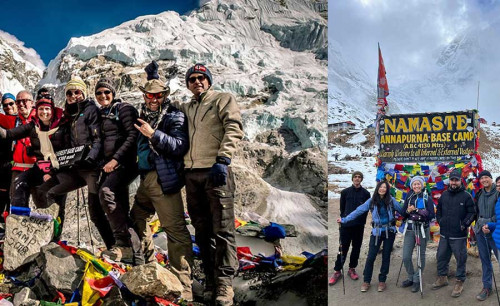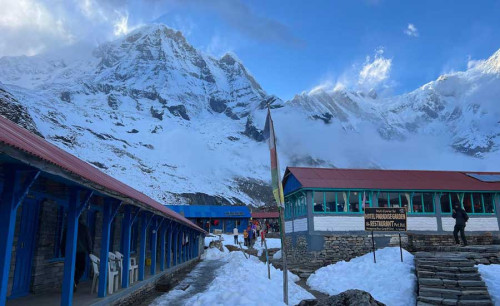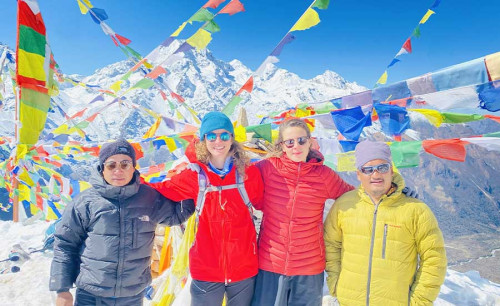Distance from Kathmandu to Mount Everest
Published On : 29th Oct, 2024 By Himalayan Dream Team

Understanding the Distance from Kathmandu to Mount Everest: How far is Everest?
Do you want to know the distance from Kathmandu to Mount Everest?, If yes, go thoroughly with this blod whis tries to calrify you the distance from Kathmandu to Mount Everest. Kathmandu, the capital of Nepal, is often the starting point for those planning to visit Mount Everest, the world's highest peak. Many people wonder about the distance from Kathmandu to Everest Base Camp and how to get there. This guide explores the various distances and routes involved in reaching Everest, along with practical information for trekkers and travelers.
The distance from Kathmandu to Mount Everest varies depending on the mode of transportation. By road, the journey to Mount Everest Base Camp is approximately 150-200 kilometers; however, due to rugged terrain and limited access roads, the actual travel route is longer and can take several days by car or bus. There is currently no direct train route from Kathmandu to Mount Everest, so road trips remain the primary option for reaching the base of the world’s highest peak. Many travelers opt for a scenic flight from Kathmandu to Mount Everest, which takes about an hour, providing a breathtaking aerial view of the Himalayas.
Alternatively, travelers can embark on a combination of road and trekking routes. A typical Kathmandu to Everest Base Camp by road journey involves a drive to Lukla or Jiri, followed by a multi-day trek to reach the camp. While driving from Kathmandu to Mount Everest by car or bus offers a scenic yet challenging adventure, the distance covered can vary based on the route and stops along the way. For those seeking convenience, flights remain the quickest way to shorten the Nepal to Mount Everest distance before continuing on foot to the base camp.
Kathmandu to Mount Everest Distance : How Far?

| Route | Distance by Flight/Drive | Trekking Distance | Total Distance (Round Trip) | Duration (Round Trip) |
|---|---|---|---|---|
| Kathmandu to Lukla and Trek to EBC | 135 – 140 km (Flight) | 60 – 65 km | 400 – 410 km | 11 – 22 days |
| Jiri/Phaplu to Everest Base Camp Trek | 130 – 140 km (Drive) | 120 – 125 km | 520 – 530 km | Varies |
Geographical Overview
The distance from Kathmandu to Mount Everest, the world's highest peak, is approximately 160 kilometers (100 miles) in a straight line. However, reaching Everest involves navigating through the rugged terrain of the Himalayas, which significantly extends the travel distance and time. The journey to Everest typically begins with a flight from Kathmandu to Lukla, a small town in the Khumbu region, which takes about 30 to 45 minutes. From Lukla, trekkers embark on a multi-day trek through scenic trails that wind through deep valleys, dense forests, and traditional Sherpa villages before reaching Everest Base Camp. The entire trek from Lukla to Everest Base Camp spans about 65 kilometers (40 miles) and can take around 10 to 14 days, depending on the pace and acclimatization needs.
Kathmandu, located in the central part of Nepal, serves as the gateway for adventurers aiming to explore the majestic peaks of the Himalayas. Despite the relatively short straight-line distance from Kathmandu to Mount Everest, the journey is an adventure in itself, requiring careful planning and preparation. The trek offers breathtaking views of snow-capped mountains and unique cultural experiences in the Sherpa communities. Travelers must be prepared for high-altitude conditions, which can pose challenges, but the experience of reaching Everest Base Camp is immensely rewarding. Understanding the distance and the trekking route from Kathmandu to Mount Everest is crucial for anyone planning this iconic adventure, offering a blend of natural beauty and cultural richness that makes it a once-in-a-lifetime experience.
As-the-Crow-Flies Distance

The straight-line distance from Kathmandu to Mount Everest is approximately 160 kilometers (100 miles), but this direct measurement does not reflect the actual travel distance due to the complex Himalayan terrain. The journey to Everest involves navigating through rugged landscapes, steep valleys, and high-altitude paths, which extend the travel distance significantly. Most adventurers begin their expedition with a flight from Kathmandu to Lukla, a small town known as the gateway to the Everest region. This flight covers about 138 kilometers (86 miles) and takes around 30 to 45 minutes. Once in Lukla, trekkers embark on the renowned Everest Base Camp trek, which spans approximately 65 kilometers (40 miles) and typically takes 10 to 14 days, depending on acclimatization and pace.
The trek from Lukla to Everest Base Camp offers a mesmerizing journey through the heart of the Himalayas, with views of snow-capped peaks, dense forests, and vibrant Sherpa villages. While the straight-line distance between Kathmandu and Everest may seem short, the trek demands preparation and endurance, as it involves significant altitude gains and challenging terrains. Trekkers traverse through iconic stops such as Namche Bazaar, Tengboche, and Dingboche, each offering unique cultural and scenic experiences. Understanding the true trekking distances and routes from Kathmandu to Mount Everest is essential for those planning this adventure, as it provides insights into the logistical and physical demands of reaching the world’s highest peak. This journey, although challenging, is immensely rewarding, offering an unparalleled blend of natural beauty and cultural immersion.
Trekking Route Distance from Kathmandu to Everest Base Camp
| Route | Walking Distance (km) |
|---|---|
| Kathmandu to Everest Base Camp | ~62 (from Lukla) |
| Lukla to Everest Base Camp | ~62 |
| Phakding to Lukla | ~10 |
| Namche Bazaar to Everest Base Camp | ~30 |
| Tengboche to Everest Base Camp | ~17 |
| Pheriche to Everest Base Camp | ~12 |
| Lobuche to Everest Base Camp | ~8 |
| Gorak Shep to Everest Base Camp | ~3 |
These distances reflect approximate trekking distances from Lukla to Everest Base Camp, which is the common trekking route taken by most trekkers.
The most common trekking route to Everest Base Camp (EBC) starts from Lukla, a small town with an airport that serves as the gateway to the Everest region. From Kathmandu, trekkers typically fly to Lukla, then begin their journey to EBC. The trek from Lukla to Everest Base Camp covers approximately 62 km and usually takes 8-12 days, depending on the pace and acclimatization stops.
The trekking route includes several key locations, such as Namche Bazaar, Tengboche, and Dingboche, each with its unique charm and significance. Along the way, trekkers experience the stunning scenery of the Himalayas and the warm hospitality of the Sherpa communities.
Air Travel from Kathmandu to Everest Region
Most trekkers begin their journey to Everest Base Camp with a flight from Kathmandu to Lukla, which serves as the starting point for this iconic trek. The flight departs from Tribhuvan International Airport in Kathmandu and lands at Lukla Airport, taking approximately 30 minutes. Lukla Airport is famous for its short and challenging runway, nestled between rugged mountain peaks, providing a thrilling experience for travelers. Despite its reputation, the flight offers breathtaking aerial views of the Himalayan range, allowing passengers to catch their first glimpses of majestic peaks, including Mount Everest. This flight is often considered one of the highlights of the trip, setting the stage for the adventure that lies ahead.
Upon arrival in Lukla, trekkers are greeted by the crisp mountain air and the vibrant local culture of the Khumbu region. From here, the trek to Everest Base Camp begins, leading adventurers through picturesque Sherpa villages, dense forests, and awe-inspiring landscapes. The route is filled with suspension bridges, colorful prayer flags, and stunning vistas of the Himalayas, providing a unique blend of natural beauty and cultural immersion. As trekkers ascend towards Everest Base Camp, they experience the rich traditions and hospitality of the Sherpa people, making this journey not only a physical challenge but also a cultural exploration. The flight from Kathmandu to Lukla is the gateway to an unforgettable trekking experience, offering both excitement and anticipation as trekkers embark on their quest to reach the base of the world’s highest mountain.
Kathmandu to Everest Base Camp: Best Routes and Distances

From Kathmandu, Nepal's capital, you can reach both the southern Everest Base Camp in Nepal and the northern Everest Base Camp in Tibet. While many assume that the southern base camp is easier to access, the travel time from Kathmandu to the northern base camp in Tibet is often shorter. Below, we provide a breakdown of the distances and routes, along with helpful travel tips for each option.
Kathmandu to Everest Base Camp Distance Comparison
| Route | Mode of Transport | Distance | Time |
|---|---|---|---|
| Kathmandu to Everest Base Camp (Nepal) via Lukla | Flight to Lukla + Trekking | 203 km (Flight: 138 km, Trek: 65 km) | 12-17 days (including acclimatization) |
| Kathmandu to Everest Base Camp (Tibet) via Gyirong Border | Overland by Car | 504 km (Drive) | 1-2 days |
| Kathmandu to Everest Base Camp (Tibet) via Lhasa | Flight to Lhasa + Overland by Car | 600+ km (Drive after Flight) | 7-8 days |
1. Kathmandu to Everest Base Camp in Nepal via Lukla
The closest base camp to Kathmandu is the southern Everest Base Camp in Nepal. To reach it, you need to take a flight from Kathmandu to Lukla, which covers a distance of 138 km. After arriving in Lukla, trekkers will cover an additional 65 km on foot, making it a 203 km round trip. This trek typically takes 12-17 days, depending on acclimatization and weather conditions.
2. Kathmandu to Everest Base Camp in Tibet via Gyirong Border
The journey to the northern Everest Base Camp in Tibet is shorter and requires less physical effort. The route involves an overland drive from Kathmandu to Gyirong Border, which is 504 km in total. After passing through the border, it takes a full day to reach the base camp at 5,200 meters. The entire journey can be done in 1-2 days, making it a quicker alternative to the trek in Nepal.
3. Kathmandu to Everest Base Camp in Tibet via Lhasa
The longer yet scenic route to Everest Base Camp in Tibet involves flying from Kathmandu to Lhasa, followed by an overland drive. The flight covers 572 km, and the drive from Lhasa to Everest Base Camp adds over 600 km. This route takes 7-8 days and includes stops at major attractions like Yamdrok Lake and Shigatse.
Which Route is Best for Visiting Everest Base Camp?
The best route depends on your preferences. For adventure lovers who enjoy trekking, the Kathmandu to Everest Base Camp via Lukla is ideal. However, for those who prefer shorter travel times and less physical exertion, the Tibet route via Gyirong or Lhasa is a great option. Either way, the majestic views of Mount Everest await at both base camps.
Pokhara to Mount Everest distance

Pokhara is approximately 200 km from Mount Everest in a straight line. However, because of the mountainous region, reaching Everest from Pokhara by road requires much more distance, since there are no direct routes.
Trekkers generally go from Pokhara via roadway or a short flight to Kathmandu, onward to Lukla by flying. From Lukla, it is about 65 kilometers of trekking distance to base camp; this normally takes approximately 12 to 14 days round trip.
Additional Factors Affecting Travel Distance
The journey from Kathmandu to Everest Base Camp involves several factors that influence travel distance and time. These include:
- Terrain: The mountainous landscape requires trekkers to navigate steep ascents and descents.
- Altitude: Acclimatization is crucial as the trek reaches altitudes over 5,000 meters. Trekkers need to plan for rest days to adjust to the thinner air.
- Weather Conditions: The best time to trek is during the pre-monsoon (March to May) and post-monsoon (September to November) seasons when weather conditions are more stable.
Tips for Travelers and Trekkers
For those planning to trek from Kathmandu to Everest Base Camp, here are some tips:
- Hire a Guide or Porter: Local guides and porters can enhance your experience and help with the physical demands of the trek.
- Get the Necessary Permits: You'll need a Sagarmatha National Park Permit and a Khumbu Pasang Lhamu Rural Municipality Permit to trek in the Everest region.
- Stay Hydrated and Well-Fed: Proper nutrition and hydration are essential at high altitudes.
- Respect Local Customs and Culture: The Sherpa people have rich traditions, so be respectful of their customs and practices.
Top Trekking Options in the Everest Region
Each route to Everest provides different landscapes, cultural experiences, and spectacular views. Some popular options for Everest trekking, suiting different trekking preferences of the people, are listed below:
Trek to Everest Base Camp

The classic Everest Base Camp Trek is the most famous route, taking trekkers from Lukla through traditional iconic Sherpa villages and dense rhododendron forests. A number of the main highlights include stops at Namche Bazaar, Tengboche Monastery, and the thrilling vista viewpoint of Kala Patthar.
Duration: 14–16 days.
Everest Base Camp Trek with Helicopter Return

Ideal for those in a hurry, the Everest Base Camp Trek with Helicopter Return follows the traditional trail to base camp but offers a luxurious helicopter return to Kathmandu from Gorakshep, saving several days.
Duration: 8–10 days.
Everest Three Passes Trek

The Everest Three Passes Trek crosses over three high-altitude passes: the Kongma La, Cho La, and Renjo La. It's a challenging trek with some of the best views in the Himalayas, Mount Everest, Lhotse, and Ama Dablam.
Duration: 18–21 days.
Luxury Everest Base Camp Trek
This Luxury Everest Base Camp Trek melds adventure to the base camp with comfort, using high-class lodges and services en route, thus allowing trekkers to enjoy extra amenities at higher altitudes.
Duration: 12–14 days.
Pikey Peak Trek
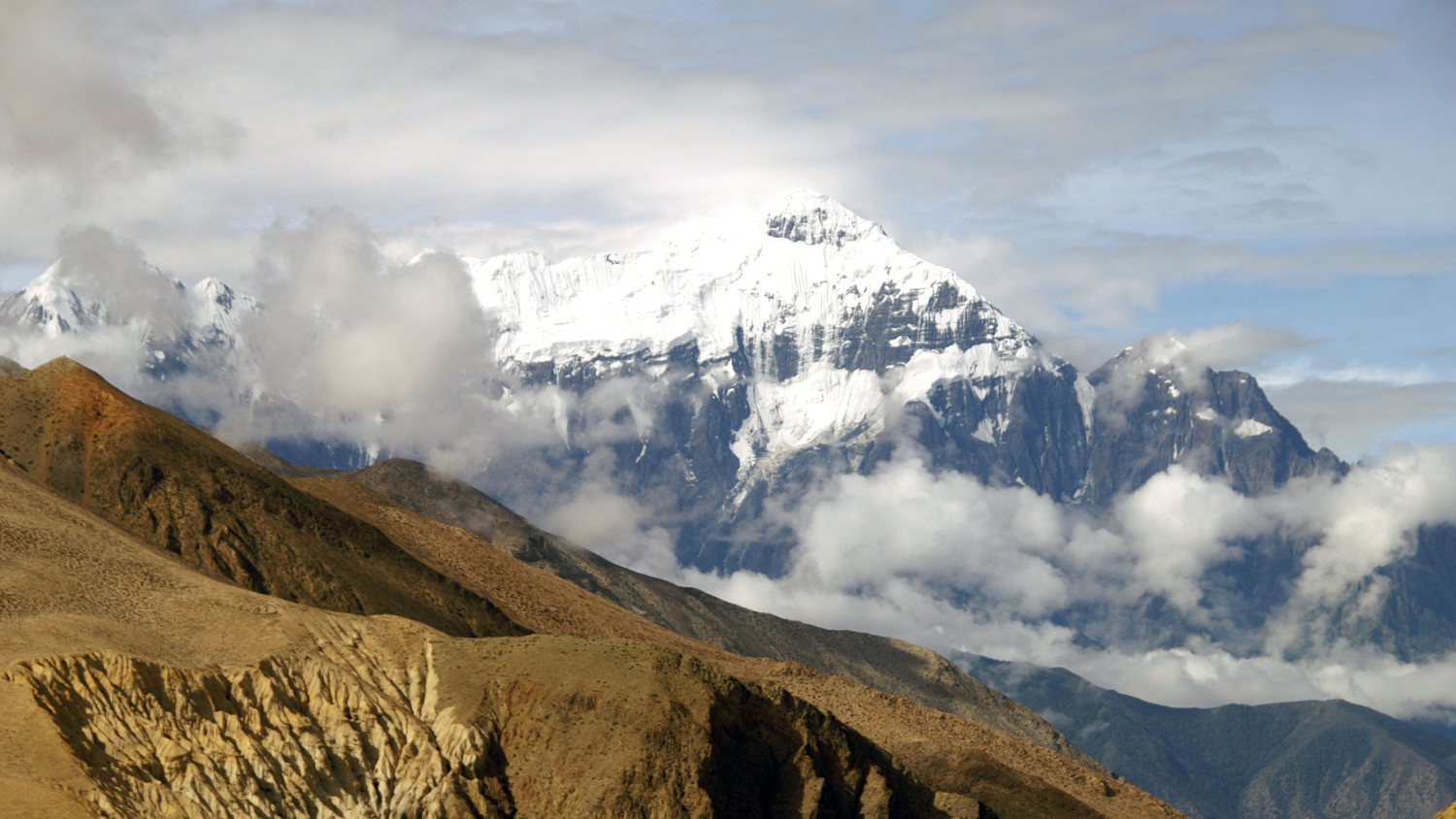
Known for panoramic views that include Mount Everest, the Pikey Peak Trek is a rather short and less crowded trek ideal for beginners. The scenic beauty of this trail itself was recommended by Sir Edmund Hillary.
Duration: 5–8 days.
Everest Base Camp via Gokyo Lakes and Cho La Pass
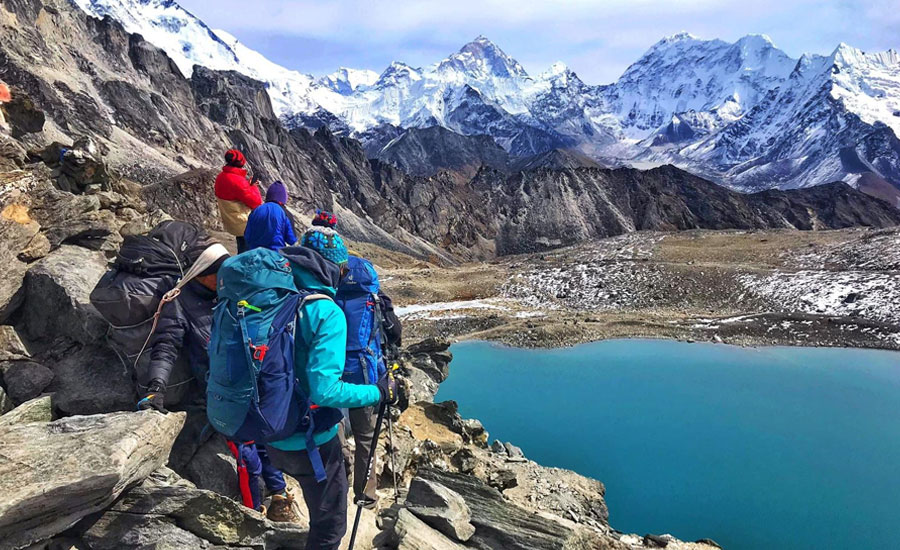
This is a variation of the Everest Base Camp trek that includes stunning Gokyo Lakes and an exciting ascent over Cho La Pass before finally reaching base camp. The mesmerizing turquoise lakes with glaciers will always leave the trekkers amazed.
Duration: 16–18 days.
Arun Valley to Everest Base Camp

Arun Valley to Everest Base Camp Trek For a quieter and more scenic approach, this starts from the lush Arun Valley and gradually links to the Everest region. It is an ideal track for nature lovers, which is less known.
Duration: 20–25 days.
Everest View Trek

Everest View Trek: This is a shorter version of the Everest trek, which has been designed for those people who want to see the mighty Everest without the hassles that go with trekking to its base camp. The trek reaches Tengboche, a village with breathtaking views of Mount Everest and surrounding peaks.
Duration: 5–7 days.
Gokyo Lakes and Gokyo Ri Trek
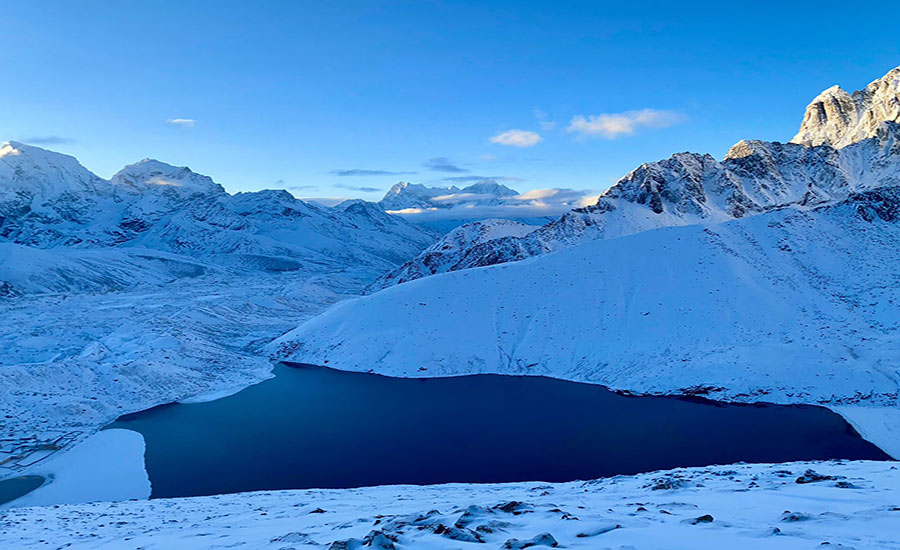
Gokyo Lakes and Gokyo Ri Trek: This focuses on the pristine Gokyo Lakes and ascends to Gokyo Ri for panoramic views of Everest and other peaks. Actually, this is a great alternative to the main base camp trail.
Duration: 12–14 days.
Each of these routes offers a lifetime of memories and can be customized to include various add-ons, from luxury accommodations to helicopter returns. Be it the classic Everest Base Camp trek, a trek to Gokyo Lakes and Gokyo Ri, or the Everest Three Passes Trek-each dream finds its equivalent in the Everest region.
Conclusion
The distance from Kathmandu to Mount Everest is approximately 160 kilometers (100 miles) in a straight line, but the journey to Everest Base Camp involves much more than this direct measurement suggests. Travelers typically begin their adventure with a flight from Kathmandu to Lukla, which covers about 138 kilometers (86 miles) and takes around 30 minutes. This thrilling flight offers spectacular views of the Himalayas and serves as the starting point for the trek to Everest Base Camp. The trekking route from Lukla spans approximately 65 kilometers (40 miles) and winds through diverse landscapes, including dense forests, steep valleys, and traditional Sherpa villages. Trekkers must navigate challenging terrains and high altitudes, making the journey both physically demanding and incredibly rewarding.
Whether you choose to trek or fly, the journey from Kathmandu to Everest Base Camp trek is an unforgettable experience that offers a unique blend of adventure, culture, and natural beauty. Along the way, travelers can immerse themselves in the rich traditions of the Sherpa people, explore vibrant markets in Namche Bazaar, and enjoy breathtaking views of towering peaks like Ama Dablam and Lhotse. Each step brings you closer to the base of Mount Everest, providing a sense of accomplishment and awe. If you’re planning a trip to this iconic destination, it's crucial to be well-prepared and equipped for the journey ahead. This includes understanding the physical demands of the trek, acclimatizing properly to the altitude, and packing appropriate gear to ensure a safe and enjoyable adventure in the heart of the Himalayas.
FAQS
1. What is the straight-line distance from Kathmandu to Mount Everest?
The straight-line distance from Kathmandu to Mount Everest is approximately 160 kilometers (100 miles). However, this direct measurement does not account for the actual travel routes or the challenging terrain between the two locations.
2. How long does it take to travel from Kathmandu to Lukla by plane?
The flight from Kathmandu's Tribhuvan International Airport to Lukla Airport takes about 30 to 45 minutes. This short but scenic flight is the most common way for trekkers to reach the starting point of the Everest Base Camp trek.
3. How far is Lukla from Everest Base Camp?
The trekking distance from Lukla to Everest Base Camp is approximately 65 kilometers (40 miles). This trek typically takes 10 to 14 days, depending on the trekker's pace and acclimatization needs.
4. Why is the flight from Kathmandu to Lukla necessary for the Everest trek?
The flight from Kathmandu to Lukla is necessary because it bypasses the rugged and challenging terrain of the Himalayas, making the journey to Everest Base Camp more accessible and manageable for trekkers.
5. Can you travel from Kathmandu to Everest Base Camp by road?
There is no direct road access from Kathmandu to Everest Base Camp. Trekkers must fly to Lukla and then continue on foot. Some overland routes to the Solukhumbu region exist but require significantly more time and logistical planning.
6. What is the elevation gain from Lukla to Everest Base Camp?
The elevation gain from Lukla (2,860 meters/9,383 feet) to Everest Base Camp (5,364 meters/17,598 feet) is approximately 2,504 meters (8,215 feet). Trekkers must acclimatize gradually to prevent altitude sickness.
7. How difficult is the trek from Lukla to Everest Base Camp?
The trek from Lukla to Everest Base Camp is considered moderately difficult. It involves long days of hiking, high altitudes, and rugged terrain. Proper preparation and acclimatization are essential for a successful trek.
8. Are there alternative trekking routes to Everest Base Camp?
Yes, there are alternative trekking routes to Everest Base Camp, such as the Gokyo Lakes route or the Jiri to Lukla trail. These routes offer different scenery and challenges, often taking longer to complete.
9. What is the best time of year to travel from Kathmandu to Everest Base Camp?
The best time to trek to Everest Base Camp is during the spring (March to May) and autumn (September to November). These seasons offer stable weather, clear skies, and moderate temperatures, ideal for trekking.
10. What should trekkers expect during the flight from Kathmandu to Lukla?
Trekkers can expect a thrilling experience during the flight from Kathmandu to Lukla. The short runway and mountainous terrain make it one of the world's most challenging airports. The flight provides stunning views of the Himalayas.
11. How does the terrain between Kathmandu and Everest affect the journey?
The terrain between Kathmandu and Everest is mountainous and rugged, requiring trekkers to navigate steep ascents, descents, and river crossings. This challenging terrain adds complexity to the journey and requires physical endurance.
12. How do trekkers acclimatize to the altitude on the way to Everest Base Camp?
Trekkers acclimatize by taking rest days at key points, such as Namche Bazaar and Dingboche, to allow their bodies to adjust to higher altitudes. Slow ascent, hydration, and avoiding overexertion are crucial for acclimatization.
13. Is it possible to see Mount Everest from Kathmandu?
Mount Everest is not visible from Kathmandu due to the distance and intervening mountain ranges. However, clear views of Everest can be seen during the flight to Lukla and along the trekking route.
14. What challenges do trekkers face when traveling from Kathmandu to Everest Base Camp?
Trekkers face challenges such as altitude sickness, variable weather conditions, and physical exertion. Proper preparation, acclimatization, and awareness of the symptoms of altitude sickness are essential for a safe journey.
15. Can travelers customize their trek from Kathmandu to Everest Base Camp?
Yes, travelers can customize their trek by choosing different routes, adding extra days for acclimatization, or including side trips to places like Gokyo Lakes or the Tengboche Monastery. Working with experienced guides and tour operators can help tailor the trek to individual preferences and fitness levels.
These FAQs provide essential information for travelers planning a journey from Kathmandu to Everest Base Camp, highlighting the logistics, challenges, and preparations needed for this iconic adventure.
Recent Posts
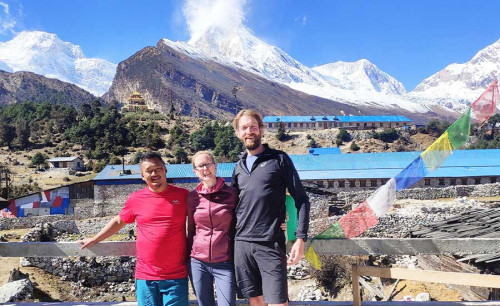
24th Nov, 2025
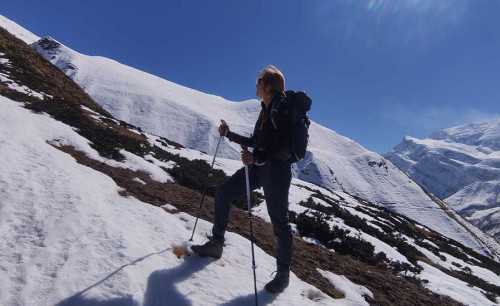
21st Nov, 2025
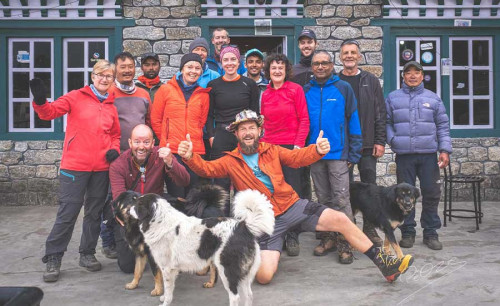
10th Nov, 2025
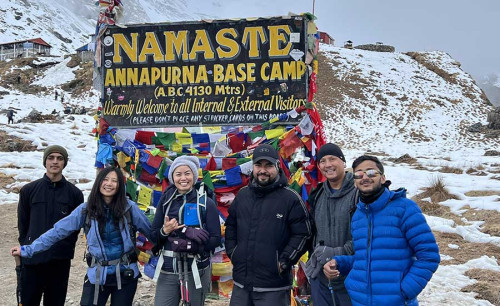
9th Nov, 2025

25th Oct, 2025

22nd Oct, 2025

17th Oct, 2025

17th Oct, 2025

13th Oct, 2025

12th Oct, 2025


